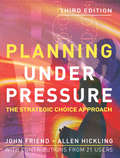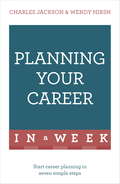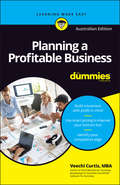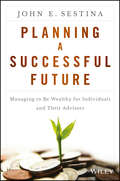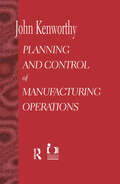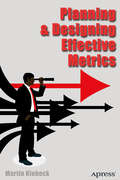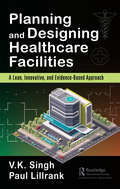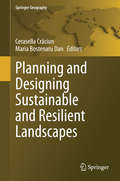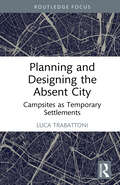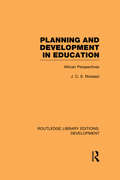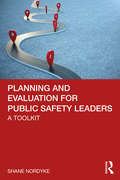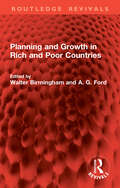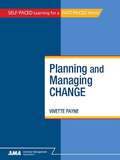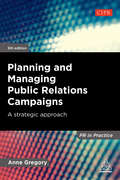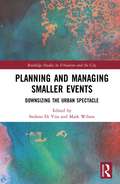- Table View
- List View
Planning Under Pressure
by John Friend Allen HicklingPlanning under Pressure offers managers, planners, consultants and students a comprehensive and authoritative guide to the Strategic Choice Approach, which has gradually been attracting worldwide recognition as a fresh, versatile and practical approach to collaborative decision-making under uncertainty. Starting from basic principles, the book uses helpful diagrams and clear explanations to demonstrate practical ways of approaching daunting decision problems; of devising possible ways forward; and of working effectively towards agreed courses of action. Along he way, decision makers are helped to cope with diverse sources of uncertainty – technical, political, managerial – in a strategic manner.In this extended third edition, the authors have added short contributions from 21 users from seven countries. These new contributors present lessons from their varied experiences in adapting the Strategic Choice Approach to guide decision-making and learning in settings ranging from the re-routing of a controversial city carnival procession to national policy for the management of nuclear waste.
Planning Wild Cities: Human–Nature Relationships in the Urban Age (Routledge Research in Sustainable Urbanism)
by Wendy SteeleThis book critically engages with the contemporary challenges and opportunities of wild cities in a climate of change. A key focus of the book is exploring the nexus of possibilities for wild cities and the eco-ethical imagination needed to drive sustainable and resilient urban pathways. Many now have serious doubts about the prospects for humanity to live within cities that are socially just and responsive to planetary limits. Is it possible for planning to better serve, protect and nurture our human and non-human worlds? This book argues it is. Drawing on international literature and Australian case examples, this book explores issues around climate change, colonization, urban (in)security and the rights to the city for both humans and nature. It is within this context that this book focuses on the urgent need to better understand how contemporary cities have changed, and the relational role of planning within it. Planning Wild Cities will be of particular interest to students and scholars of planning, urban studies, and sustainable development, and for all those invested in re-shaping our ‘wild’ city futures.
Planning Your Career In A Week: Start Your Career Planning In Seven Simple Steps
by Charles Jackson Wendy HirshPlanning your career just got easierVery few of us put much effort into planning for the kind of career we want. Thinking about where we are going at work is something we all need to do throughout our working lives. The nature of work and employment is always changing. When economic times are difficult, you need to show potentialemployers that you have something special to offer. You may also need to be more flexible in your plans. New kinds of jobs emerge all the time and many labour markets are becoming increasingly specialized. This means you need to find out more about the kinds of jobs that interest you, and you need to understand what employers are looking for and how people get these jobs. By working through a simple series of steps and exercises, you can help yourself to be clearer about what you want, what your options are, and how to move forward. Exercises in each chapter will help you build a collection of information and reflect on what you are learning about yourself and the process of career planning as you go along.Planning Your Career In A Week looks at one step in this process of career planning on each day of the week: Sunday: What do you want from work?Monday: What kind of job would you enjoy?Tuesday: What are you good at?Wednesday: Identifying your career optionsThursday: Collecting informationFriday: Making the choiceSaturday: Taking the first steps
Planning Your Career In A Week: Start Your Career Planning In Seven Simple Steps
by Charles Jackson Wendy HirshPlanning your career just got easierVery few of us put much effort into planning for the kind of career we want. Thinking about where we are going at work is something we all need to do throughout our working lives. The nature of work and employment is always changing. When economic times are difficult, you need to show potentialemployers that you have something special to offer. You may also need to be more flexible in your plans. New kinds of jobs emerge all the time and many labour markets are becoming increasingly specialized. This means you need to find out more about the kinds of jobs that interest you, and you need to understand what employers are looking for and how people get these jobs. By working through a simple series of steps and exercises, you can help yourself to be clearer about what you want, what your options are, and how to move forward. Exercises in each chapter will help you build a collection of information and reflect on what you are learning about yourself and the process of career planning as you go along.Planning Your Career In A Week looks at one step in this process of career planning on each day of the week: Sunday: What do you want from work?Monday: What kind of job would you enjoy?Tuesday: What are you good at?Wednesday: Identifying your career optionsThursday: Collecting informationFriday: Making the choiceSaturday: Taking the first steps
Planning Your Career Through Intense Interests
by Barb Cook Yenn PurkisPlanning a career around your special or intense interests is possible and, in fact, easier than you might think! If you're wondering how you can turn your love of animals, intense fascination of transportation or passion for information technology (and much more!) into a fulfilling career, that you will never get bored of, you've come to the right place!Yenn Purkis and Barb Cook are leading autistic advocates, employees and business owners and are using their first-hand knowledge and the power of special interests to help you plan your future in this book. By straying from the conventional paths and thinking differently, Yenn and Barb could help take your passion for outer space and help transform you into a budding astronomer or even aerospace engineer!Full of helpful advice and activities, including goal and vision setting, identifying your skills and personality attributes, looking at what makes a positive workplace, common attributes of autistic employees and business owners and challenging assumptions to name just a few, this book will help you to find work that you truly enjoy and thrive in the workplace.
Planning a Life in Medicine: Discover If a Medical Career Is Right for You and Learn How to Make It Happen (Career Guides)
by Princeton Review John Smart Stephen Nelson Julie DohertyA life in medicine is something that many dream of but few achieve. The tests students face-both literal and figurative-just to get into medical school are designed to weed out the weak. In Planning a Life in Medicine, the experts at The Princeton Review help you succeed in a premedical program, score higher on the MCAT, meet the challenges of medical school, and ultimately flourish in your medical career. More than just a comprehensive plan for getting into medical school, Planning a Life in Medicine is a handbook that will help you to cultivate the skills and habits-such as compartmentalizing knowledge and improving concentration-that will help you along your "path of heart" and serve you well throughout your education and medical career.
Planning a PRINCE2 Project In A Day For Dummies (In A Day For Dummies)
by Nick GrahamWhether you’re very experienced in running projects, or absolutely new to it, PRINCE2 can help you run your projects more effectively. Planning a PRINCE2 Project In a Day For Dummies is designed to give you a one-day steer into the essentials of running the Initiation stage of a PRINCE2 project. It focuses on just one process – Initiating a Project – and one theme – Plans. This quick, handy guide is essential reading for anyone undertaking a new PRINCE2 project and for those interested in learning more about how PRINCE2 can improve their projects. Open the book and find: Planning the work of your project Deciding on appropriate controls Working up a detailed Business Case Creating your PID or ‘Project Initiation Documentation’ Online resources include: Ten tips for a good business case PRINCE2 glossary Gallery of images from the book
Planning a Profitable Business For Dummies
by Veechi CurtisYou don’t need to be a ‘numbers person’ to make your business profitable! With Planning a Profitable Business For Dummies, discover the secrets of financial success and how to generate above-average profits. Planning a Profitable Business For Dummies explains how to build a business with profit in mind, using smart pricing techniques and clear-eyed strategic planning. Whether you’re just getting started in business or still recovering from lockdown losses, this book points to where extra profits might lie. Flip through these pages to learn the importance of competitive positioning, smart pricing, and how best to secure an enduring advantage over your competitors. Reflect on how you can transition to becoming an entrepreneur, rather than just a business owner, and why this distinction is so important. Make a safe-and-sound transition into working for yourself by using proven business strategies Discover the fundamentals of financial projections, margins, and ratios — even if you aren’t a math whiz Secure finance for your business and manage your working capital wisely Identify savvy expense-saving ideas, and, when the time is right, sell your business for the highest price Business owners need straightforward, practical tips that ensure that extra edge of profitability. Find these tips inside this book, and pave your path to financial success.
Planning a Successful Future
by John E. SestinaA deeply insightful guide to goal-based financial planning and wealth management Planning a Successful Future empowers advisors and clients to take control of their money and manage their income to achieve their financial goals. Written by the father of fee-only financial planning, this book features real-life stories and examples from over three decades in the industry to illustrate how financial planning works and the best way to create your strategy. You'll learn how to identify and prioritize your goals, and why they're important--and how to get where you need to be for retirement, education, home ownership, and more. Practical exercises get you started on the right track, and useful checklists keep you organized and focused along the way. You'll get expert insight on risk management, allocation, tax reduction, estate planning, and more, as you develop your strategy and put it into action. The financial services industry undergoes frequent changes, and financial planning specifically is affected to a high degree. Keeping up with the latest news and distinguishing trend from legitimate methodology can itself be a fulltime job. This book gives you the background you need to create a plan, and make the smart choices that will help you grow and protect your wealth. Create a realistic and goal-based financial plan Take a more proactive approach to your finances Identify your goals and how to achieve them Allocate investments appropriately for your situation Financial planning is complex, with many variables to analyze and outside forces that can derail even the best laid plans. Planning a Successful Future gives you the information, tools, strategies, and insight you need to make the best decisions for your financial future.
Planning and Budgeting (Linking Operational Control Processes to Strategy)
by Robert S. Kaplan David P. NortonIntegrating the Balanced Scorecard with an organization's planning and budgeting processes is critical for creating a Strategy-Focused Organization. Most organizations use the budget as their primary management system for establishing targets, allocating resources, and reviewing performance, and few have integrated their budgeting and performance review processes with the strategic planning process. This chapter shows how companies have used a strategy-focused management system based on the Balanced Scorecard to integrate these processes and overcome important barriers to strategy implementation.
Planning and Control of Manufacturing Operations (The\oliver Wight Companies Ser. #3)
by John KenworthyEffective planning and control of manufacturing operations allows businesses to achieve maximum profitability by reducing uncertainty at all stages of the manufacturing process. In this book, John Kenworthy offers an easy to follow overview of the principles and practice of manufacturing control, with the emphasis throughout on practical approaches and techniques rather than on theoretical discussion. The author demonstrates that many problems are common to different types of manufacturing enterprises and offers practical solutions which can lead to a dramatic increase in overall performance. Sales forecasting, distribution planning, capacity planning, scheduling, and continuous improvement policies are among the subject areas covered. Exercises at the end of each chapter help readers assimilate important points. This book will be an invaluable aid not only for industrial managers who are responsible for manufacturing planning and control, but also students, trainers and anyone wishing to increase their understanding of manufacturing control systems.
Planning and Designing Effective Metrics
by Martin KlubeckMetrics are a hot topic. Executive leadership, boards of directors, management, and customers are all asking for data-based decisions. As a result, many managers, professionals, and change agents are asked to develop metrics, but have no clear idea of how to produce meaningful ones. Wouldn't it be great to have a fast, simple explanation of how to plan for and then design measurements to improve your organization?Planning and Designing Effective Metrics--an abridged version of author and metrics expert Martin Klubeck's Metrics: How to Improve Key Business Results--provides that explanation and the tools you'll need to make your organization more effective. Not only does this brief book explain the 'why' of metrics, but it walks you through a step-by-step process to create a clear picture of organizational health and how well you satisfy customer needs. This book: Provides a guide for planning and designing useful metrics based on your unique organizational needsOffers the theory behind metrics to help you get exponentially better practical resultsShows how to select and use the proper tools for creating, implementing, and using metricsProvides examples of how to identify, collect, analyze, and report metrics that will be immediately useful for improving all aspects of the enterprisePlanning and Designing Effective Metrics will help you to measure the right things, the right way--the first time. No wasted effort, no chasing data. You will learn how to create valuable measures of organizational success, like repeat customers, customer loyalty, and word-of-mouth advertising. That will help you not only to improve organizational results--you'll also multiply your career opportunities.
Planning and Designing Healthcare Facilities: A Lean, Innovative, and Evidence-Based Approach
by Paul Lillrank Vijai Kumar SinghThe planning and design of healthcare facilities has evolved over the previous decades from "function follows design" to "design follows function." Facilities stressed the functions of healthcare providers but patient experience was not fully considered. The design process has now crucially evolved, and currently, the impression a hospital conveys to its patients and community is the primary concern. The facilities must be welcoming, comfortable, and exude a commitment to patient well-being. Rapid changes and burgeoning technologies are now major considerations in facility design. Without flexibility, hospitals face quicker obsolescence if designs are not forward-thinking. Planning and Designing Healthcare Facilities: A Lean, Innovative, and Evidence-Based Approach explores recent developments in hospital design. Medical facilities have been adapted to the requirements of clinical functions. Recently, the needs of patients and clinical pathways have been recognized. With the patient at the center of the process, the flow of tasks becomes the guiding principle as hospital design must employ evidence-based thinking, and process management methods such as Lean become central. The authors explain new concepts to reduce healthcare delivery cost, but keep quality the primary consideration. Concepts such as sustainability (i.e., Green Hospitals) and the use of new tools and technologies, such as information and communication technology (ICT), Lean, and evidence-based planning and innovations are fully explained.
Planning and Designing Sustainable and Resilient Landscapes
by Cerasella Crăciun Maria Bostenaru DanThis book deals with planning issues in landscape architecture, which start at the evaluation of the existing fabric of society, its history and memory, approached and conserved through photography, film and scenographic installations, a way in which the archetypes can be investigated, be it industrial derelict sites or already green spaces and cultural landscapes. It provides approaches to intervention, through rehabilitation and upgrade, eventually in participative manner. To such evaluation and promotion a couple of disciplines can contribute such as history of art, geography and communication science and of course (landscape) architecture. The field of landscape architecture reunites points of view from such different disciplines with a view to an active approach a contemporary intervention or conservation. The book presents case studies from several European countries (Romania, Germany, Austria, Italy, Portugal) mostly for large landscape in the outskirts of the cities and in the parks.
Planning and Designing the Absent City: Campsites as Temporary Settlements
by Luca TrabattoniThis book concerns the study of open-air accommodation facilities. The market evolutions allow us to look at these structures as temporary settlements characterised by a low-density dwelling and a close connection with natural elements and the landscape.This new and different point of view is sustained by the tendency of outdoor tourism to go in the direction of temporary villages, and this tendency is directly related to "time" and "landscape". The landscape is the reason why the campsite is settled. The time is linked to the holiday season timing. Today, both are greatly influenced by the introduction of the "Maxi-Caravan". This removable living unit can be placed on the empty pitch, occupying the landscape without ruining the soil. By the settlement of Maxi-Caravans, the campsite is transformed from an empty landscape with tents to a temporary settlement, whose timing is divided between the seasonal timing of the campsite and the "timing" of the product, and whose landscape is organised by the relation with the prevalent landscape and the internal one. The book's core defines the outdoor facility structure, using Italy as the main case study. To identify design strategies, the book analyses temporary settlement examples (quick time) and projects from historic outdoor tourism (medium time). Finally, the last chapter reflects on open-air accommodation facilities by showing their applicability in the different contexts of the refugee camps (long time).The aim of this research is to enhance the theme of open-air accommodation facilities, highlighting the need to equalise the study of temporary settlements with that of permanent settlements. It will be of interest to researchers and students of planning, landscape and tourism.
Planning and Development in Education: African Perspectives (Routledge Library Editions: Development)
by J.C.S. MusaaziThis reissue, first published in 1986, offers a comprehensive treatment of educational development in four countries in West and East Africa: Nigeria, Uganda, Kenya and Tanzania. The author focuses on the role of education in promoting or hindering national development; the way the educational system varies in response to societal and dialectical forces; the place of education in major theories of change and development; and the contribution made by education to economic, social and political development. Clearly and concisely written, the book will be of interest to teachers, administrators, educational planners and scholars in comparative education and the history of education.
Planning and Economics of Cities: Shaping India′s Form and Future
by Prasanna K MohantyHow should India urbanize the cities and tackle the issues of their planning and economics? A key factor behind the poor urban planning in developing countries such as India is the lack of understanding of land, transport and urban economics. Due to this, urban planning models are majorly unsuccessful in addressing the issues of affordable housing, transport and other basic amenities for the urban poor numbering more than a quarter of urban residents. Planning and Economics of Cities: Shaping India’s Form and Future presents theoretical and empirical research to address the shortcomings in India’s present models and suggests reforms in the current approaches. It incorporates the economics of cities into the urban planning to address the issues in India’s transition to a developed country. It also illustrates best practices from India and other countries to guide reforms in urban planning and development in this country.
Planning and Evaluation for Public Safety Leaders: A Toolkit
by Shane NordykePlanning and Evaluation for Public Safety Leaders presents field-tested techniques and tips to help public safety leaders effectively manage their organizations and overcome challenges. Organizations and agencies operating within the public safety sector are unique in many respects. These unique elements provide a different context in which planning, and performance measurement occur. Without recognizing this particular context, most public planning texts ignore crucial pieces of the puzzle when it comes to effectively achieving and measuring public safety outcomes. This book’s practical approach equips students with approachable explanations specific to the public safety context, and practical tools for public safety leaders that can apply to their organizations. Key Features • Each chapter begins with a real-world case from the public safety sector that highlights the importance or possible application of the information covered. • Cases are written in close coordination with the public safety practitioners to illustrate how the concepts covered in the chapter work in a real-world public safety context. • "Put it into Practice" Reflections at the end of each chapter allow new or future public safety leaders to apply the material directly to their current organization. • Boxes describe how to use and apply specific methods in a concise and easy to find tools addressing planning and evaluation challenges as they arise • Key terms and application questions written specifically for students, focus in on the most important concepts and terms from the text. • Overviews of relevant theoretical and scholarly work on the concepts offer connections with course material.
Planning and Growth in Rich and Poor Countries (Routledge Revivals)
by A. G. Ford Walter BirminghamOriginally published in 1966, this book was written at a time when economists realized that rapid growth in developing nations could not be achieved without comprehensive planning and that no economy could be left to grow of its own accord without the danger of major fluctuations in economic activity and long periods of stagnation. Written by a team of academic economists who combined specialized knowledge of the theory of economic growth with world-wide experience of its practical applications, this volume provides an intelligent analysis of the problems of economic growth which faced nations that had embarked on the planning of their economies such as the UK, India, Ghana, Sierra Leone and New Zealand.
Planning and Managing Change
by Vivette PayneOrganizational change can be difficult. The ability to manage change has become a key competency for those seeking to enhance either personal or corporate efficiency and effectiveness. Planning and Managing Change provides a structured and practical approach to dealing with change. This book teaches the importance of proactively managing change and avoiding the knee-jerk reactions that undermine efforts to deal with the organizational and human issues that accompany change. Readers will learn how to: • Manage the process, content and human dynamics of change • Help others move successfully through the change process • Diagnose the impact of change • Identify how to engage the support of others • Determine key success factors for evaluating change effectiveness • Monitor change implementation • Plan and manage change to enhance adaptability and ensure continuous learning
Planning and Managing Public Relations Campaigns
by Anne GregoryGetting a public relations campaign or programme off the ground can seem overwhelming. Planning and Managing Public Relations Campaigns provides a blueprint for all practitioners. Practical and easy to read, the book presents a 12-point plan for ensuring success of campaigns of all sizes, covering many vital areas including the role of public relations in organizations, the importance of context, research and analysis, setting objectives, strategy and tactics, timescales and resources, evaluation and review. Planning and Managing Public Relations Campaigns is widely regarded as one of the best 'how-to' guides for students and practitioners. This fully updated fourth edition features new developments in public relations, including social media, along with new case studies including WRAP's Love Food, Hate Waste campaign; The Sleep Pod Hotel Media Tour; McArthur River Mining; AkzoNobel's Corporate Revolution; the UK Department of Culture, Media & Sport's First World War Centenary Commemorations; and Lanson's campaign for unbiased.co.uk. About the PR in Practice series: Published in collaboration with the Chartered Institute of Public Relations (CIPR), the PR in Practice series consists of accessible, practical introductions to day-to-day public relations practice and management issues. The series' action-oriented approach keeps practitioners' knowledge and skills up to date.
Planning and Managing Public Relations Campaigns: A Strategic Approach (Pr In Practice Ser.)
by Anne GregoryTaking a public relations campaign from planning through to implementation can seem overwhelming. Planning and Managing Public Relations Campaigns provides a blueprint for success, and is widely regarded as one of the best 'how-to' guides for students and practitioners. Digestible and easy to read, this fifth edition presents a 12-point plan for ensuring success of campaigns of all sizes, covering vital areas including the role of public relations in organizations, the importance of context, research and analysis, setting objectives, strategy and tactics, timescales and resources, evaluation and review.With discussion of new developments in the industry, from the gig economy and online influencers, to disruptive models, this fully updated new edition addresses the need for agile planning and draws on fresh case studies to provide up-to-date examples of best practice. Supported by a suite of online resources, Planning and Managing Public Relations Campaigns is an invaluable guide for students and practitioners alike. Online resources include extended case studies, lecture slides, discussion questions and assessment tasks.
Planning and Managing Smaller Events: Downsizing the Urban Spectacle (Routledge Studies in Urbanism and the City)
by Stefano Di VitaPlanning and Managing Smaller Events: Downsizing the Urban Spectacle explores the role of smaller-scale events in contributing to the renewal and development of urban societies. This book adopts a case study approach to examine a diverse range of events taking place in towns and cities in Europe, Asia and North America. This volume begins by defining and classifying these kinds of events and then verifying if and how they can provide opportunities for cities and towns without the disadvantages of world-famous large events. It concludes by discussing the growing regional scale of urban phenomena and their transition in post-metropolitan spaces. Planning and Managing Smaller Events: Downsizing the Urban Spectacle will be of interest to government officials and policy makers involved in economic development, urban planning, parks and arts/culture, as well as students and researchers interested in urbanism, event management, tourism and recreation.
Planning and Managing Sustainability in Tourism: Empirical Studies, Best-practice Cases and Theoretical Insights (Tourism, Hospitality & Event Management)
by Levent Altinay Anna Farmaki Xavier FontThis book provides a holistic approach to understand the challenges and opportunities related to the planning and management of sustainable development in tourism. The editors present a collection of empirical studies, best-practice cases, and theoretical discussions to draw insights on the economic, social, environmental, and political dimensions of sustainability. Specifically, using a range of case studies examining sustainability applications within various tourism industry sectors as well as different geographical regions, this book is of value to tourism policymakers, practitioners, academicians, and students, encouraging them to develop proactive behavior. This publication represents an up-to-date, innovative guide in helping readers understand the challenges facing sustainable tourism development and implementation as well as the potential opportunities for both developed and developing nations in pursuing sustainability goals in their tourism plans.
Planning and Managing a Corporate Event
by Karen LindseyIncludes the Ultimate Tick List, A-Z Survival Guide, 50 Top Tips and Useful Contacts. This book provides comprehensive and expert guidance on planning and managing a corporate event. It is written as a support text for students studying event management and to provide a practical guide for aspiring event organisers along with administrators, secretaries and personal assistants who are required to organise events as part of their job role. Within this book and its numerous check lists you will discover how to: * Become a proficient event organiser and consistently achieve excellent results with the least amount of fuss, stress and worry. * Consider the step-by-step process from beginning to end for a wide range of events including conferences, award ceremonies, parties, team building, activities, family fun days and press and product launches. * Deliberate all aspects of an event including the event brief, location, costing, theming and logistics. * Apply Health & Safety standards without the headache and take Sustainability measures in your stride. * Competently manage the event on site including tips on what to do when things don't go to plan. * avoid time-consuming and frustrating pitfalls.
